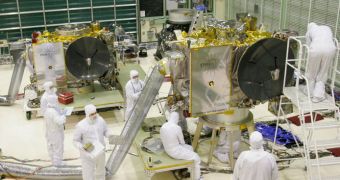A group of investigators specializing in studies of the Sun held a conference on Tuesday, in which they discussed the challenges and threats ahead. Their concerns were prompted by the fact that the star is currently beginning to wake up, as in to exhibit increased levels of activity. After a couple of years in which it remained less active than expected, it's currently beginning to emit more solar flares, and to produce solar storms, which can affect our planet is a very bad way. The experts gathered to discuss methods of ensuring the damage to Earth and its infrastructure are minimal, Space reports.
The Sun is generally governed by an 11-year cycle, which means that this period usually contains a solar maximum and a solar minimum point. The last cycle was off-balance, in the sense that the minimum period lasted for two years more than it otherwise would have. As the star picks up on its activity, it's beginning to develop more sunspots, which are the darker, cooler areas on its surface. When these spots explode, solar storms are formed. These events trigger the release of massive amounts of charged particles in the Sun's neighborhood, which also includes Earth.
When streams of such particles reach our planet, they can wreak havoc on satellites, power grids, as well as on the International Space Station (ISS). The damages large solar storms can provoke are enormous, and so it falls with the scientific community to ensure that we have the greatest degree of protection possible. “The Sun is waking up from a deep slumber, and in the next few years we expect to see much higher levels of solar activity. At the same time, our technological society has developed an unprecedented sensitivity to solar storms. The intersection of these two issues is what we're getting together to discuss,” explains the head of the NASA Heliophysics Division, Richard Fisher,
In a report published two years ago by the National Academy of Sciences (NAS), experts underlie the threats associated with a large solar storm taking place. The document, entitled “Severe Space Weather Events – Societal and Economic Impacts,” shows that damages from such an event would exceed those caused by Hurricane Katrina about 20 times or so. The trick to reducing these potential damages is knowing when the storm hits. “Space weather forecasting is still in its infancy, but we're making rapid progress,” explains the director of the Boulder, Colorado-based US National Oceanic and Atmospheric Administration (NOAA) Space Weather Prediction Center, Thomas Bogdan.
“I believe we're on the threshold of a new era in which space weather can be as influential in our daily lives as ordinary terrestrial weather. We take this very seriously indeed,” Fisher believes. NOAA and NASA are already engaged in cooperative programs to keep an eye on the Sun, operating a fleet of satellites around the star and Earth.

 14 DAY TRIAL //
14 DAY TRIAL //